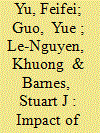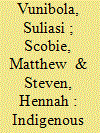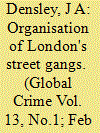|
|
|
Sort Order |
|
|
|
Items / Page
|
|
|
|
|
|
|
| Srl | Item |
| 1 |
ID:
179664


|
|
|
|
|
| Summary/Abstract |
The reported effects of electrification on rural entrepreneurship are mixed, with recent studies describing heterogeneity in outcomes and methodological challenges in attributing causal effects. Furthermore, the debate largely focuses on performance outcomes, rather than supply- and demand-side barriers to productive electricity use itself. In this paper, we contribute new evidence describing electricity use among micro- and small-enterprises (MSEs) in rural northern India. Puzzlingly, 34% of the 2,004 MSEs surveyed have no grid-connection despite almost complete village grid electrification. We exploit variation in grid supply hours at village level, finding no conclusive link with this and MSE connection likelihoods. Rather, connection likelihood appears to be more closely related to wealth characteristics. Supporting this hypothesis, the reported electricity consumption appears equally unrelated to supply quality and quite low overall: 75% of grid-connected MSEs consume less than 1 kW-hour per day, powering only lighting and fans. These results are notable given the positive bias we expect due to the likely endogeneity between grid supply quality and broader development trends, as noted in recent literature. Our work follows others in arguing that supply side improvements must occur in concert with demand side initiatives to unlock rural MSE electricity consumption. At the same time, the role of off-grid technologies in meeting nascent MSE electricity needs deserves further study.
|
|
|
|
|
|
|
|
|
|
|
|
|
|
|
|
| 2 |
ID:
150766


|
|
|
|
|
| Summary/Abstract |
In this research, we aim to understand the influence of government subsidies on enterprises’ research and development (R&D) investment behavior, particularly in China’s renewable energy sector. We are also interested in examining how the attributes of enterprise ownership act as a moderating variable for the relationship between government subsidies and R&D investment behavior. Three classical panel data analysis models including the pooled ordinary least squares (OLS) model, the fixed effect model and the random effect model are employed. We find that government subsidies have a significant crowding out influence on enterprises’ R&D investment behavior and that the influence is further moderated by the attributes of enterprise ownership. Moreover, a panel threshold regression model is used to demonstrate how the influence of government subsidies on enterprises’ R&D investment behavior will change when government subsidies increase. Two thresholds, 0.6% and 10.1%, are identified. We recommend that relevant government departments should motivate enterprise R&D investment behavioral intention by increasing subsidies within a certain range. Different attributes of enterprise ownership should also be considered as part of policy reform and re-structuring relating to government subsidies.
|
|
|
|
|
|
|
|
|
|
|
|
|
|
|
|
| 3 |
ID:
185109


|
|
|
|
|
| Summary/Abstract |
This study examines Indigenous Fijian and Papua New Guinean enterprises on customary land. It explores the duality of merging Indigenous and Western principles of entrepreneurship and the ability to balance business and socio-cultural imperatives. A qualitative, ethnographic-case study approach is deployed, with talanoa/tok stori used to collect empirical materials. Two interrelated themes emerged from the study: The need for Indigenous enterprise models to contribute to a more holistic conception of well-being, and as a result, the requirement to rethink how surplus is distributed beyond mainstream shareholder ownership models. This study reveals a more nuanced approach to distributing surplus based on Indigenous conceptions of kinship. The specific theoretical contribution of this study is an Indigenous conception of surplus distribution that offers a challenge to traditional shareholder models.
|
|
|
|
|
|
|
|
|
|
|
|
|
|
|
|
| 4 |
ID:
109858


|
|
|
|
|
| Publication |
2012.
|
| Summary/Abstract |
This article examines a grossly neglected area of the street gang literature: the nature and extent of gang organisation. Based upon fieldwork with gangs in London, UK, this article illustrates how recreation, crime, and enterprise are not specific gang 'types', but rather represent sequential stages in the evolutionary cycle of gangs. This article demonstrates not only how gangs typically begin life as neighbourhood-based peer groups, but also how, in response to external threats and financial commitments, gangs grow to incorporate street-level drug distribution businesses that very much resemble the multi-level marketing structure of direct-selling companies. Gang organisation, in turn, becomes a function of gang business. Gang organisation is conceptualised here on three levels: internal, external, and symbolic. This article examines, respectively, the presence of subgroups, hierarchy and leadership, incentives, rules, responsibilities, and punishments within gangs; how gangs interact with the local and larger community; and how gangs associate with symbolic elements of popular culture in order to convey reputation and achieve intimidation.
|
|
|
|
|
|
|
|
|
|
|
|
|
|
|
|
|
|
|
|
|